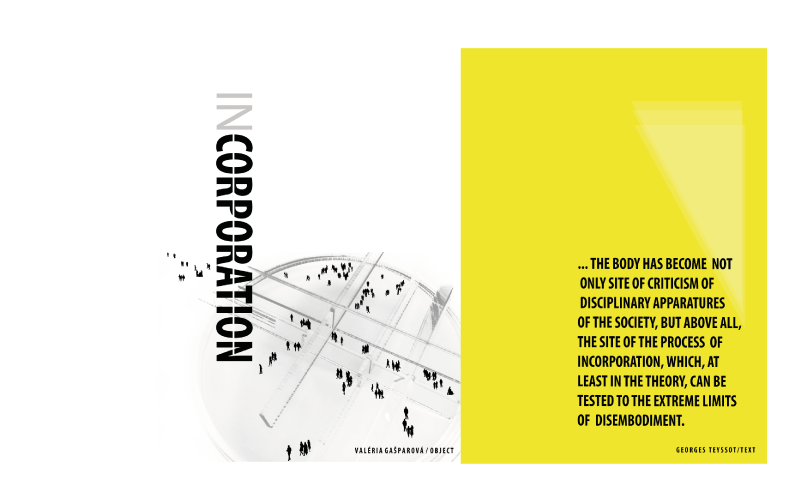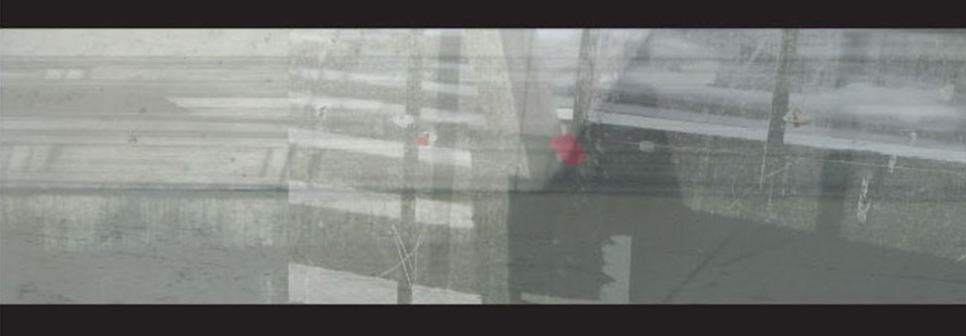Valéria Gašparová home page
‘Foyer’ Berlin
Foyer of the Kunsthochschule Berlin-Weißensee, Bühringstr. 20,130 86 Berlin
Opening 18.11.| 18:11 CET
Monday – Friday 08:00- 20:00, 18.11.- 12.12.2014
An exhibition by Valeria Gasparova, Kveta Kazmukova, Angelina Tasic, Katerina M. Vaclavkova, Katarina Patrasova, Irina Valkova
“Foyer” would admittedly be a peculiar name for an exhibition about stations, ports and transitory spaces of all sorts. Come to think of it, the name in itself is strange enough. Far from a room with a fireplace, a hearth of a settlement, where one feels cozy and protected, increasingly more people spend large parts of their lives in such foyers, which seem to be designed precisely not to let anyone be there long. They gather temporary inhabitants with one common aim: wanting to get somewhere else. As any transitory ground, the exhibition in our foyer, will also build upon distinct focuses: a projective and an immediate approach to reality. Artistic praxis and its commonly refereed to auratic experience of the “here and now” will confront architectural works, usually assimilated to a project-like view of reality.
Of course, the transitional place can truly come to be, only if both approaches happily engage – which is no easy task. The visitor can await architectural projects doing their best to incorporate “here and now” – the works of art to extol an ever
absent presence, evading in projections. The distant ways of the authors meet to bare a terrain, which one may suspect uncomfortable or spare and therefore more eagerly leave, than notice. Thus we had recourse to the somewhat out-aged custom of a “Platzkarte”. The fleeting format of an exhibition like ours practically demands it. Maybe nothing can find a house in foyers, but fluctuation. With this little card we invite the visitor to not only pass and miss it, but assure him a position, a place to be -long. Consider it something of a charm before a journey.
Supported by Mart Stam Gesellschaft.
Text: Kveta Kazmukova
Subway. Collage. 2005 … thinking about the theme of the transitory spaces (the subject of the exhibition), I found an interesting sentence:…specific subject matters pertaining current challanges: poverty, informality, migration, governance…1
I had the idea that we could built it not only on interpretations of forms of ‘‘ rooms“ into geometry, whether in the form of graphics, prints…etc., but we could also think about other relationships, such as for instance, non-formality, control, social differences…Previously I was more inclined to abstraction and the quality of visual arts, but I think that this can be linked with such contents. I also noticed, how interesting it is to be involved with one theme for a long period and to compare the approach and ways of thinking in the distance of time.
1(FLC)Future Cities Laboratory, Territorial Organisation, Constructing dialogues between in vitro and vivo research, p.30
The conceptualization of plexiglass objects refers to my personal theme: spatial reinterpretations of concrete places. In my work I try to transcribe 2D spatial records, such as authorial notations, drawings, photographs, etching etc. into 3D transparent objects. Transparent plexiglass helps to visualize this process. The physical properties of this material – its visual transmittance produces effects of light, which appear to me as directly pointing to the transient. Paradoxically, 2D graphic notations are always fixed, trapped on surface. There are no direct connection with existing space. For these reasons, I decided to construct real physical models, each one inspired by a selected text. The selected writings deal with topics such as: embodiment, incorporation, parasitism, mind-inhabiting and mutation. In comparison to my previous work, where my activities were more intensively oriented on spatial recording of the visual kind, in this project I focus more on language, generally on written description of space. The creative process begins with autonomous interpretations of these selected texts.

1. EMBODIMENT
Model M 1: 2000Defining the conditions of domestification, spheres become envelopes, ontological membranes between interior and exterior. Spheres determine ( and are determined by) the interval between here and there. Places between proximity and distance, between finite and infinite, camped between the terminated and indeterminate, located between the symbolic and the diabolical, spheres are defined precisely by an inter-betweeness, from the Latin root inter that is also part of interior, intermediary and even intermediality.
Spheres offer an opportunity to stop somewhere, to domesticate, to interiorize, at the same time through an “ek-static“ process (from Greek, ek-stasis, “stepping forth “), spheres offer an opening toward symbolism and language, in the direction of the external world, offering access to objects beyond reach such as the horizon and stars.
From: TEYSSOT, G. : Architectural embodiment Prosthetics and Parasites. In Mario CARPO, M., LEMERLE, F.(eds.) Perspective, Projections & Design, Technologies of Architectural Representation, London, Routledge 2007, pp. 186-87.
2. INCORPORATION
Model M 1: 500
3. PARASITISM
Model M 1: 5000At the heart of this problematic is the urgent question of the interaction between framework and prosthesis: frame as extension and projection of instrumentality, prosthesis as a new form of hospitality. From them, we must work on concepts of hostility, unusualness, discomfort, alienation, and the uncanny. Indeed, a prosthetics, like a graft or transplant, can be simultaneously hospitable and hostile. It vacillates between those two poles, hopes and hostis, guest and enemy, hospitality and hostility, as is already recognized on the surgical level.
The realm of replacement then opens on to possibilities of placement, displacement, and replacement a new definition of the term ”place.”
From: TEYSSOT, G. : Architectural embodiment Prosthetics and Parasites. In Mario CARPO, M., LEMERLE, F.(eds.) Perspective, Projections & Design, Technologies of Architectural Representation, London, Routledge 2007, p. 184.
4. MIND-INHABITING
A subject is not a mind inhabiting a body, far from having a body, we are a body-indeed, a body whose parts all ”think”. Thus created, our bodies become even more visible, more proliferating, more polymorphic, more saturated, more contracted in ” masses “ and “zones”, more than they ever been”. (Nancy Corpus, p. 78.)
From: TEYSSOT, G. : Architectural embodiment Prosthetics and Parasites. In Mario CARPO, M., LEMERLE, F.(eds.) Perspective, Projections & Design, Technologies of Architectural Representation, London, Routledge 2007, p. 184.
5. MUTATION
Model M 1: 1 000 000Those semi-human, semi-synthesized, constantly mutating entities are already environments, surfaces where relationships of self to come into play. It thus entails a reconsideration of the body, literally (re)crafting it as improved organism equipped with instruments, so that it can ”inhabit” the world and negotiate transaction with the multiple spheres of physical and mental comfort, media and information. The interior of the dwelling, finally, may be redefined as the movement of the body toward the exterior, in a state of ek-stasis, through the various filters which delimit our surroundings (places, vicinities, gateways, thresholds, frameworks, ledges, windows, openings, vistas, frontiers, borders, breakthroughs, gaps, screens, interfaces, cables, wireless networks).
From: TEYSSOT, G. : Architectural embodiment Prosthetics and Parasites. In Mario CARPO, M., LEMERLE, F.(eds.) Perspective, Projections & Design, Technologies of Architectural Representation, London, Routledge 2007, pp. 187-88.

